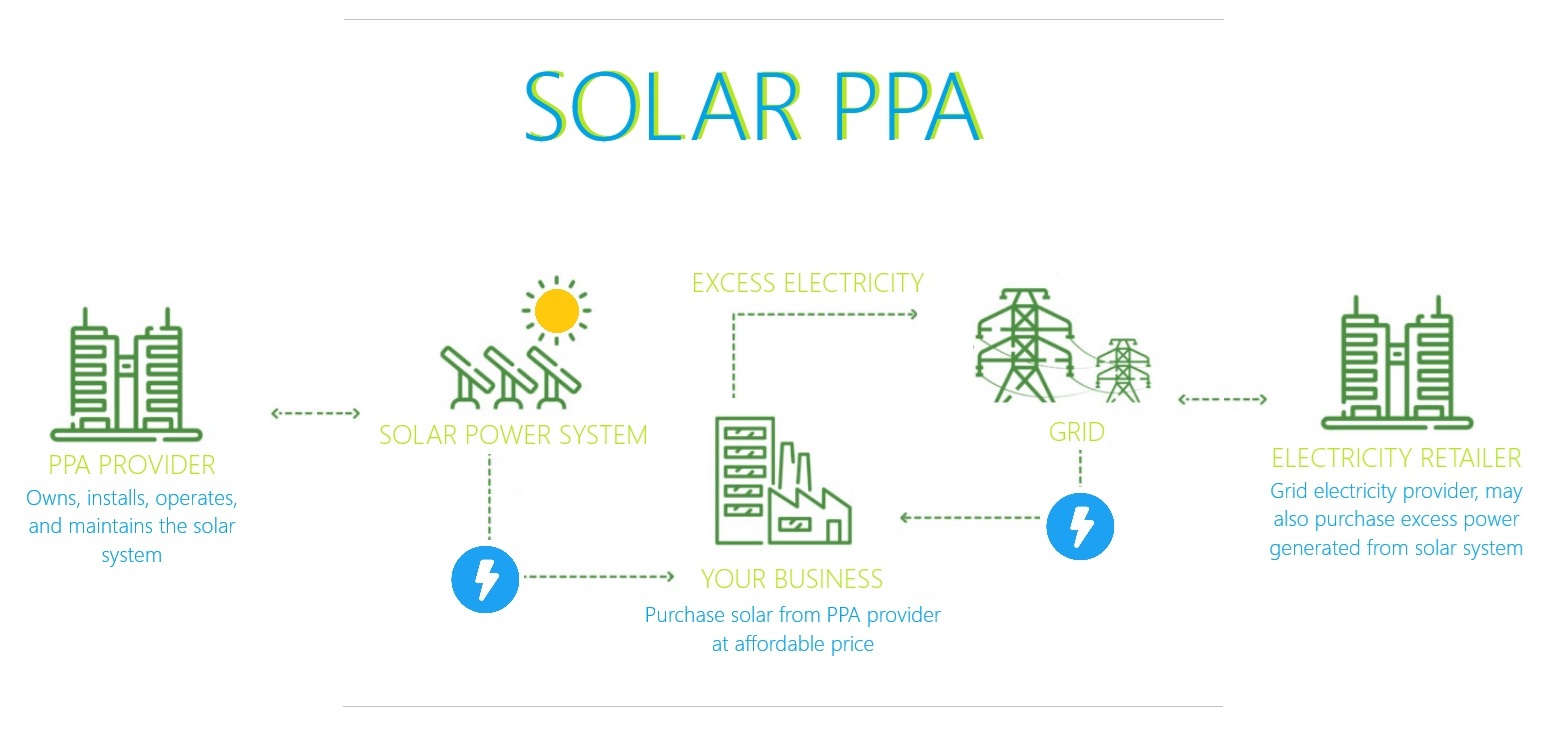Solar Consumption
Commercial Solar Power Systems can be categorized based on their system design, usage and functionality.
Solar Power Purchase Agreements (PPAs)
Businesses purchase solar energy directly from a provider without owning the solar installation. This model is cost-effective and eliminates maintenance responsibilities.
What is Solar Power Purchase Agreements (PPAs)?
A Solar Power Purchase Agreement (PPA) is a financial arrangement where a business or organization buys solar electricity from a third-party provider without owning the solar system. A Power Purchase Agreement (PPA) will define the duration of the off-take of the produced electricity, typically via sale to an electricity distribution company for a utility-scale solar park. The provider installs, operates, and maintains the solar panels on the customer's property, supplying electricity at a predetermined rate, often lower than traditional grid prices. This model allows businesses to benefit from solar energy without upfront capital investment or maintenance concerns. PPAs typically last 10–25 years, ensuring long-term cost savings and sustainability. The commercial lifetime, therefore, guarantees an agreed price over this period. Once the end of the PPA has been reached, the solar park will have to sell its electricity at market prices or enter into a new agreement with an electricity distribution company.
The Government of India actively promotes solar power through Solar Power Purchase Agreements (PPAs) and solar park development initiatives. The Ministry of New and Renewable Energy (MNRE) has launched schemes to facilitate large-scale solar projects, ensuring streamlined infrastructure and regulatory support for developers.
Self Consumption
Solar self-consumption refers to the use of energy generated by photovoltaic systems
located near the point of consumption by businesses.
What is Solar self-consumption?
Solar self-consumption refers to the use of energy generated by photovoltaic systems located near the point of consumption by businesses. Along with solar panels, such installations typically include inverters, cables, connectors, and batteries. This approach not only reduces electricity expenses but also promotes the use of renewable energy, helping to combat climate change.
There are two categories of solar self-consumption based on how unused energy is managed: self-consumption without surplus, where no excess energy is fed into the grid, and self-consumption with surplus, which allows surplus energy to be transmitted to the grid.
On-Grid Systems:
These systems are connected to the power grid, allowing businesses to use solar energy alongside grid electricity. Excess energy can be fed back into the grid, often with financial compensation.
What is an On-Grid Solar system?
On-grid solar systems, also known as grid-tied solar, are connected to the utility grid and supply electricity directly to homes, businesses, or industries. These systems generate solar energy during the day, which is used immediately, while any excess is fed into the grid, often earning credits through net metering. When solar production is low (e.g., at night), users draw power from the grid. On-grid systems eliminate the need for battery storage, making them cost-effective and low-maintenance. They are widely used for reducing electricity bills and promoting clean energy adoption without requiring a backup power source.
Off-Grid Systems:
Designed for locations without grid access, these systems store solar energy in batteries for uninterrupted power supply.
What is an Off-Grid Solar system?
An off-grid solar system operates independently of the electricity grid, making it ideal for remote locations or areas with unreliable grid access. These systems rely on solar panels to generate electricity and battery storage to store excess energy for use during non-sunny hours. Often paired with backup generators, they ensure uninterrupted power supply even during extended periods of low sunlight. Off-grid systems are self-sufficient but typically require higher upfront costs and maintenance compared to on-grid systems. They are particularly useful for providing energy independence, reducing reliance on fossil fuels, and enabling sustainable development in isolated regions.
Hybrid Systems:
A combination of on-grid and off-grid systems, equipped with battery storage. Businesses can utilize solar energy, grid electricity, and stored power seamlessly.
What is a Hybrid Solar system?
A hybrid solar system combines the features of both on-grid and off-grid systems, offering flexibility and reliability. These systems are connected to the power grid while also incorporating battery storage to store excess solar energy. During sunny hours, they prioritize solar energy for consumption, and any surplus is either stored in batteries or fed into the grid. During power outages or at night, the stored energy serves as a backup. Hybrid systems are ideal for areas with unreliable grid supply and are valued for their ability to ensure energy independence, reduce electricity bills, and contribute to sustainability efforts.


